Watershed Conservation
Conservation and Restoration Methods
We’re working to improve water quality by restoring the region’s rivers and streams. Our work takes several different strategic approaches and methods. The Conservancy’s watershed conservation staff has extensive experience and expertise with overall construction-project management, including permitting, working with contractors, project design and direct implementation of watershed restoration projects.
Our team also consults and works with a variety of partners on several different conservation projects and initiatives that address non-point source pollution problems. The following information provides an explanation of the type of projects we plan, implement and manage in order to improve water quality.
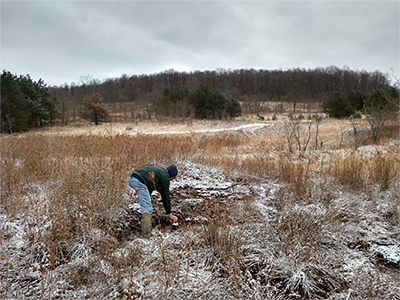
Abandoned Mine Drainage Remediation
In 1977, Congress passed the Surface Mining Control and Reclamation Act (SMCRA), establishing laws that require present-day coal mine operators to properly reclaim and restore the land that they temporarily disturb while mining coal. Prior to SMCRA, many coal mined areas were abandoned without proper reclamation, often leading to streams polluted by metals and acid, and lands left devoid of proper soils and vegetation.
Our staff works with local watershed groups and other organizations to address pollution from abandoned coal mine sites by assessing conditions, identifying problems and developing strategies to reduce or eliminate pollution from these areas. By assisting with securing funding, developing preliminary restoration designs, and assisting with the implementation of treatment systems and techniques that address the pollution, many formerly polluted areas are being successfully restored to properly functioning watersheds and landscapes.
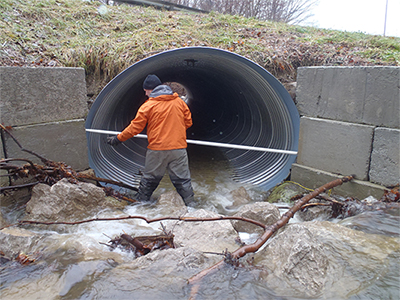
Aquatic Organism Passage
Pennsylvania’s rivers and streams have been conduits for humans since Native Americans first used trails along the river bottoms to travel across the Commonwealth. As the state became more developed, infrastructure increased including roads, bridges, culverts and dams. All of these improvements were aimed at increasing the ability to transport natural resources, such as timber and coal, with minimal provisions provided for aquatic resources including native trout, freshwater mussels and hellbenders. This has contributed to the fragmentation of watersheds, which disrupts natural pathways for the movement of aquatic organisms. Watershed fragmentation also reduces the movement of sediment and woody debris.
WPC staff work to assess problematic barriers to aquatic organism passage. We identify undersized or inadequate culverts, and dilapidated dams, and then work with the owner and our partners to complete projects that restore passage for aquatic organisms. Our work still maintains transportation needs and access. WPC uses the North Atlantic Aquatic Connectivity Collaborative (NAACC) protocol and has completed the replacement of more than 32 culverts and 29 dam removals since 2001.
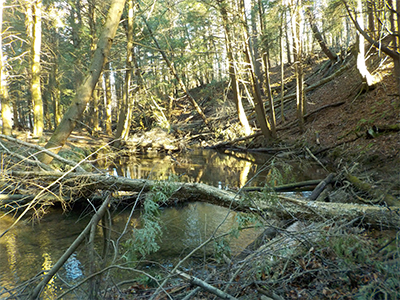
Large Woody Material Restoration
Often persisting for decades or even centuries, fallen large woody material in streams provides critical habitat conditions and ecological services. Due to centuries of unsustainable resource management techniques, most of our forests lack the larger, older trees that would naturally fall near or into streams. Large woody material replenishment techniques that mimic natural habitat conditions in undisturbed watersheds were formally developed more than 30 years ago in the western United States.
These projects help mitigate flood risk downstream, ensure cool water during summer low flows, and improve connections between aquatic and terrestrial ecosystems. Since 2013, our staff has been exploring these natural alternatives to aquatic habitat restoration in partnership with the USDA Forest Service in the remote headwater streams of the Allegheny National Forest. WPC is also facilitating discussions and training opportunities with state regulators and land management agencies to apply these practices statewide, contributing to the restoration of streams throughout western Pennsylvania.
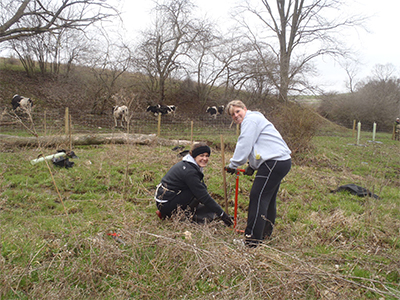
Riparian Tree Planting
Riparian areas are located where bodies of water meet land. Maintaining healthy vegetative cover along waterways is one of the most effective ways of limiting non-point source pollution, or sediment and nutrient runoff, on the land. Planting and maintaining forested riparian buffers further helps water quality by creating shade and limiting temperature fluctuations in a stream, river or creek. There are many benefits to forested buffers, including protection from accelerated erosion, creation of wildlife habitat and alleviation of downstream flooding problems. To assist in limiting non-point source pollution, we’ve planted more than 72,000 riparian trees since 2001.
A riparian restoration project involves planting approximately 200 tree and shrub seedlings per acre. All plantings are done by hand and plants can be bare-root, livestakes, and/or small (approximately 1-3 year old) potted trees and shrubs all native to Pennsylvania. Plantings can be done through contracted services or through the coordination of a volunteer activity depending on the size of the planted area. The labor involved with planting these seedlings ranges from light to heavy duty, and tasks can be found for volunteers from young to old.
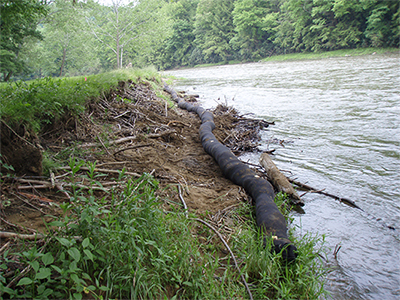
Soil Bioengineering
Soil bioengineering is a method of streambank stabilization using living plant materials to form a network of root systems to hold soil in place. This technique involves planting, driving or placing live cuttings of woody riparian plant species into the soil. The fast rooting nature of these species (primarily willows and dogwoods) allows them to quickly establish a new layer of shrub growth along the stream corridor. The network of roots that develop serves as a natural “root two-by-four” to hold the soil in place, while growth above the ground serves to slow the velocity of rushing water and reduce erosion.
Additional benefits of soil bioengineering include overhanging cover from new leaf and shoot development, carbon capture from the atmosphere and storage in new plant growth, and an enhanced living filter immediately adjacent to a stream. This vegetated riparian zone only gets better over time, as it grows and takes root. Eventually, this buffer will help reduce nutrient and chemical pollution from waste disposal systems, as well as roadway, residential and agricultural runoff.
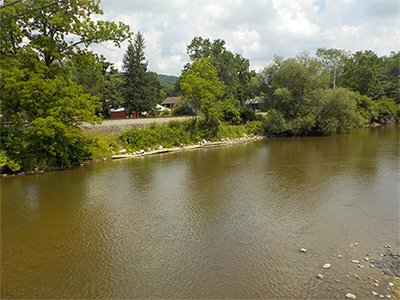
Traditional In-Stream Habitat & Streambank Stabilization
Many streams in Western Pennsylvania are affected by a variety of landscape manipulations such as farming, forestry practices, transportation infrastructure, development and resource extraction. These activities tend to accelerate rates of streambank erosion from concentrated runoff, which exacerbates erosional forces in the stream.
Our staff uses a variety of natural stream design techniques to manipulate the stream’s erosive velocities and result in a reduction of sedimentation and improved in-stream habitats. These enhancements create overhead cover, hydraulic complexity, additional woody debris and scour holes for fish and other aquatic life, thus improving the overall habitat for aquatic life in the stream.
For More Information:
Watershed Conservation Program
Western Pennsylvania Conservancy
1067 Philadelphia Street, Suite 101
Indiana, PA 15701
